Ryan FR-1 Fireball
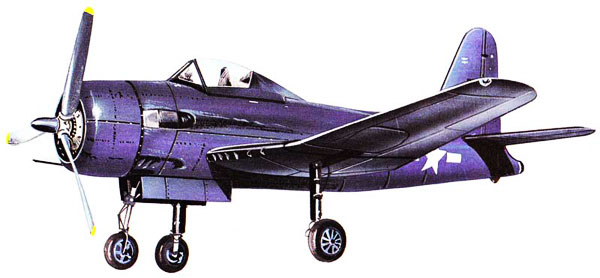
Essentially a conventional wartime fighter with a small jet engine stuffed in the back, the unfortunately named Fireball was the US Navy toe-in-the-water approach to putting jets on their aircraft carriers. The General Electric J31 engine was intended to boost performance at altitude rather than power the Fireball throughout its flight. Following early tests, the Ryan FR-1 required a substantial redesign of its tail surfaces, which initially looked quite jet like but were soon replaced with larger, more conventional units.
Improved FR-2 and FR-3 versions with different engine combinations were ordered in large quantities and then cancelled with the war's end. One example of the XFR-4 with a 34001b thrust J34 was tested. For once a Westinghouse engine provided too much thrust and worked poorly in conjunction with the piston engine.
The prototype XFR- 1 flew for the first time on June 25, 1944, the first delivery of an operational FR-1 being made to Nary Fighter Squadron VF-66 in March 1945.The aircraft used both powerplants for take-off, climb and combat, and had the ability to fly and land with either engine shut down. The Ryan Corporation's design work on the XFR-1 influenced the development of another experimental composite-power aircraft, the Curtiss-Wright XF15C- 1.
FR-1 Fireball
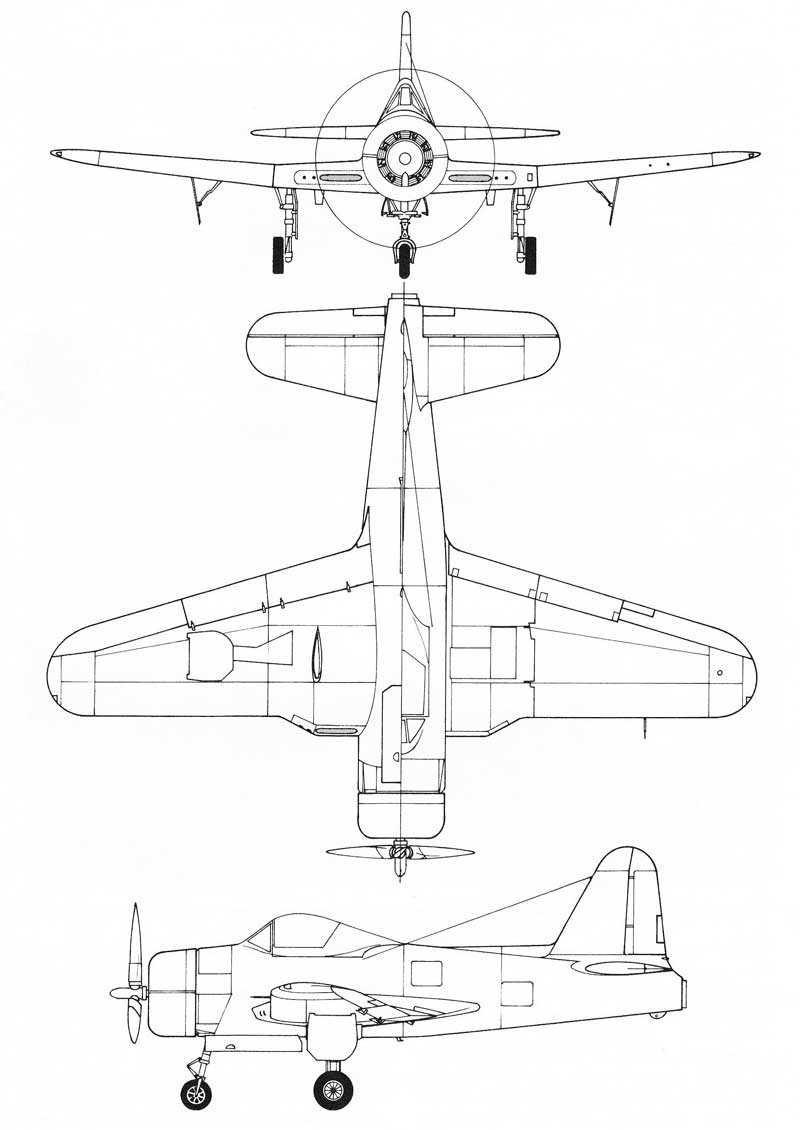
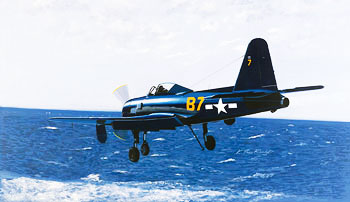 When the USAAF had already test flown its first jet-powered aircraft,
the Bell P-59A, on October 2,1942, the U.S.Navy was still undecided
whether or not to follow suit. The Bureau of Aeronautics knew that
it had no time to lose if it were not to sacrifice air-superiority through
having thoroughly out-dated planes in service: the problem seemed to
lie in the incompatibility of jet aircraft, which apparently needed long
runways, with carrier-based use.
When the USAAF had already test flown its first jet-powered aircraft,
the Bell P-59A, on October 2,1942, the U.S.Navy was still undecided
whether or not to follow suit. The Bureau of Aeronautics knew that
it had no time to lose if it were not to sacrifice air-superiority through
having thoroughly out-dated planes in service: the problem seemed to
lie in the incompatibility of jet aircraft, which apparently needed long
runways, with carrier-based use.
In late 1942, the answer suddenly presented itself: a mixed-propulsion plane to combine the respective advantages of a piston engine and the jet. In December, 1942, the U.S.Navy issued a Request for Proposals to nine aircraft manufacturers; the specification called for a carrier-based fighter whose piston engine would suit it for comparatively short take-off and landing while the second, jet engine would provide extra thrust for a fast rate of climb and emergency bursts of power when needed.
Amazingly enough the most convincing proposal was not submitted by one of the old- established companies with a long track record in this field but came from Ryan, whose only remotely relevant experience had been in building trainers and who had never attempted to design a ship-based plane. The Bureau of Aeronautics was, however, impressed with the Ryan Model28 designed by Ben T. Salmon and William T. Immenschuh and three XFR-I prototypes were ordered on February 11, 1943.
The new fighter was a cantilever low-wing monoplane of classic design, only the air intakes on the wing leading-edge and a small exhaust nozzle in the tail betrayed the fact that the plane was anything but traditional; it was powered by a Wright R-I820-72W 9-cylinder radial engine and a General Electric I-16 turbojet, both using the same type of fuel. A number of innovations had been introduced in the Fireball design, however, apart from the power plant; these included the laminar-flow folding wings; the retractable tricycle undercarriage and the fact that the entire surface of the aircraft's all-metal skin had been flush-riveted, even the control surfaces, and was completely smooth.
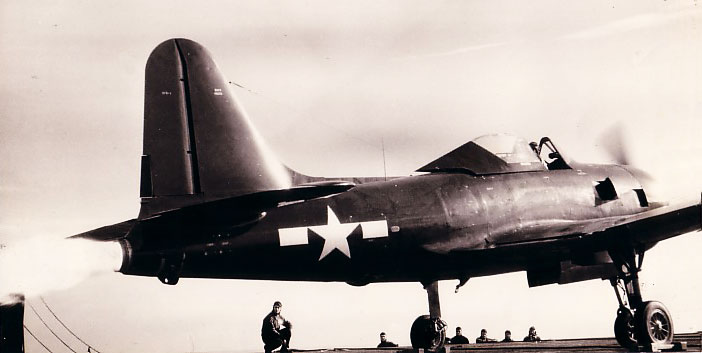
On June 25, 1944,the first XFR-1 made two successful flights, powered by the piston engine alone as the turbojet had not yet been installed. On September 20, the second prototype, fully engined, had its maiden flight and on both occasions everything went extremely well; the transition from propeller to jet engine thrust went without a hitch, the two systems being perfectly compatible. Kamikaze attacks were already proving a menace and this seemed the only hope of intercepting the planes before they dive-bombed their targets.
This led to the original procurement of 100 FR-1s placed on December 2,1943, being followed by a second order, for 600, on January 31,1945. There were, however, three accidents, two of them fatal, when the first XFR-l crashed on October 13, 1944, and the third XFR-1 on April5, 1945, while a series aircraft had crashed on March 25,but the wing structure was strengthened as a result and the program was not halted.
The first FR-1s were not assigned to existing units for service trials, instead a special Squadron was formed, VF-66 based in San Diego, with orders to complete the series of test flights in as short a time as possible so that the plane could enter service.
Deliveries of the first FR-1s began in March, 1945, and on May 1, the Fireball qualified for carrier-based use after trials aboard USS Ranger. VF-66 had yet to be pronounced combat ready when Japan surrendered and FR-l production came to an abrupt stop in November, 1945, when only 66 had been built.
On the whole the exercise had been a productive one; the Fireball had a faster rate of climb and was more maneuverable than piston-engine fighters but had a lower maximum speed. The idea that an all-jet aircraft could operate from flight decks had started to gain ground. The FR-1 still had the distinction of being the first aircraft to land on a carrier powered by jet only: on November 6, 1945, a Marine pilot, J. C. West landed on the flight deck of USS Wake Island when his piston-engine had failed, using only the General Electric J3I-GE-3 turbojet engine. VF-66 Squadron became VF-41 and later VF-lE and trials continued aboard the USS Wake Island, Bairoko and Badoeng Strait, gathering valuable data. In March, 1947, the FR-l was taken out of service.
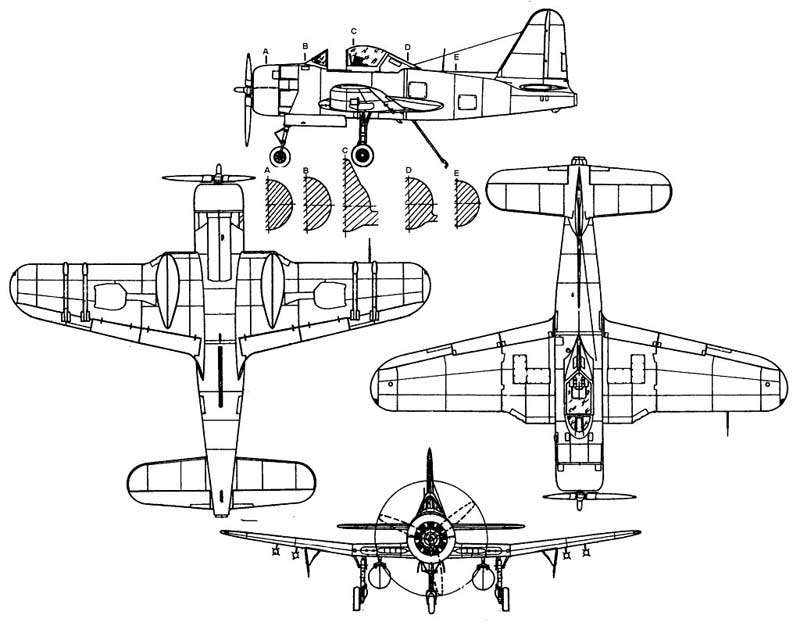
RYAN FR FIREBALL, XF2R DARK SHARK
The first gas turbine-powered flight had been made before World War II in Germany. The Air Corps began flying their first jet, the Bell XP- 59, on October 2, 1942. The Navy was quite interested in the new powerplant, but the slow acceleration of the jet made normal carrier takeoffs virtually impossible. This factor also would have a direct bearing on the landing characteristics since rapid acceleration is a requirement in the event of a wave-off during the approach. The obvious solution was to devise an aircraft with the best features of both power systems; and, in the meantime, design a fleet of carriers capable of launching and recovering the pure-jet types of the future. The British had already perfected the steam cataPult and this would become a fixture on the next generation of American carriers as well. But for the moment, the composite fighter appeared to be the most practical solution to the needs of the Navy.
Nine airframe manufacturers were asked to submit proposals for the prop-jet fighter. Among the responses was one from the Ryan Company whose main contribution to the aeronautical world was the famous "Spirit of St. Louis" and a line of popular sport planes. Their only military experience had been in the design and construction of primary trainers during the war.
Ryan presented their proposal to the Navy and a development contract for three XFR- 1 prototypes was awarded in January 1943. As the design progressed, the Navy awarded a full production contract for 100 FR-l's on December 2, 1943. The Ryan fighter, dubbed Fireball, a name given by its builder and retained by the Navy, was mainly a state-of-the-art machine. It was conventional in appearance, except for the fairly new tricycle landing gear, and gave only a hint of its composite design. The air inlets for the jet engine were inconspicuous in the wing roots, and the only indication of the second power unit was an 18 inch hole where a tail cone might be expected. The Fireball was the first carrier plane to utilize the new high-speed laminar-flow wing, though this also was not apparent to the casual observer. Its smooth exterior was due to the use of flush riveting over the entire aircraft-the first Navy plane completely finished in this manner. In addition, all control surfaces were metal-covered - another exclusive.
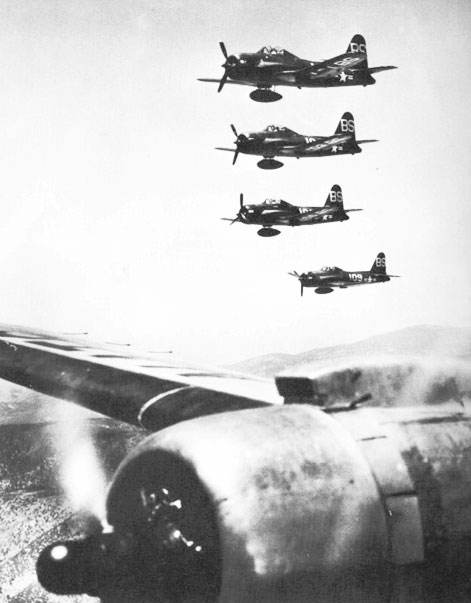 |
FR-1s in the background are flying on their jet engines. |
The first two flights of the Fireball were made on June 25, 1944, before the General Electric jet engine was installed. The XFR- 1 performed well and the jet was mounted a few days later. The two types of engines gave the Ryan fighter a remarkable versatility. The Wright R-L820-72W Cyclone had 1,350 hp and imparted good low altitude performance, while the GE 1-16 with 1,600 lbs. of thrust, performed best at higher altitudes. Initial studies showed the Fireball had a maximum speed of 430 mph, and the new airfoil gave the fighter better maneuverability than existing Navy fighters. But, the inevitable bugs began to appear and a modification program was established to eliminate the undesirable features.
Overheating of the piston engine required some rework around the cowling, and the empennage was completely revised. The horizontal stabilizer had been mounted to a rather small vertical fin. Wind tunnel studies advised a relocation of the stabilizer onto the fuselage and a substantial increase in fin area. On one occasion, the wing assembly failed during a high-speed demonstration causing the plane to plummet into a new Navy patrol bomber at the end of the runway. The pilot, who was thrown free, stated that the plane had become uncontrollable after his canopy blew off. Examination showed that the sharp edges of the metal at the bottom of the counter-sunk rivet holes rubbed against the rivets on the wing leading edge as the wing normally flexed. This action eventually weakened the rivets, causing the leading edges to separate, forcing air through the wing into the fuselage, and blowing the canopy off moments before the wing disintegrated. This flaw was to follow the Fireball throughout its service life. It was found that as long as the wings were not stressed beyond 7.5 "G's", there was no danger. To add a safety factor, operational pilots were prohibited from exceeding , "G's"; but the Fireball was so maneuverable it was sometimes accidentally overstressed leading to structural failure.
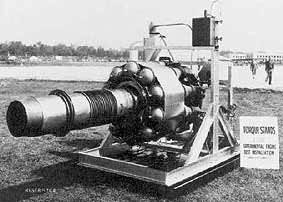 |
The I-16/J-31 was developed from the copy of Frank Whittle's W1(GE IA). |
VF-66 was the only squadron to operate the Ryan Fireball, the first plane being delivered in March 1945. Training began immediately to prepare the squadron for combat against the Japanese Ohka suicide bombs-the FR-1 was the only Navy plane with the performance to catch the rocket planes. However, before the Fireball squadron was fully qualified, the Japanese surrender cancelled their need.
For those privileged to see a Fireball in operation, it was a startling sight. The pilots seldom failed to take advantage of the composite fighter's unique ability to seemingly fly without any power. Often, the pilot of the FR-1 would cruise up beside a contemporary piston-powered fighter and casually feather the propeller on his piston engine. Before the wide eyes and gaping mouth of the unsuspecting aviator, the Fireball would then outdistance the older fighter on its jet alone.
Although the Fireball was not designed for pure-jet operation, the General Electric engine provided adequate Power for sustained flight. On one occasion this trait proved most valuable. On November 6, 1945, Ensign J. C. West took off from the USS Wake Island and soon the Wright engine began faltering. Before the piston engine failed completely, West started the jet and returned to the carrier thus, making the first landing by jet Power alone on a carrier.
Ryan's composite fighter had a 275 square foot wing with a span of 40 feet. Overall length was 32 feet 4 inches, height was 13 feet 7 inches. Maximum speed of the production Fireball was 404 mph at 17,800 feet with both engines operating. On the prop alone, the best speed was 295 mph at 76,500 feet. Service ceiling was 43,100 feet. The FR- t had an empty weight of 7,689 pounds, a gross of 9,958 pounds, maximum of 11,652 pounds. Four .50 cal. Browning MG 53-2 machine guns, with 300 rpg, were carried in the wings next to the jet air inlet, and fittings for two 1,000 pound bombs were underneath the wings.
The end of the war brought cancellations of orders for the Fireballs. Over 1,000 units had been on order, but ultimately only sixty-six of the jet/prop fighters were completed. One of these, BuNo 39661, was reworked to utilize a 1,700 hp turboprop engine in place of the piston type. This ship was redesignated XF2R- 1 and carried the nickname "Dark Shark." The new engine installation increased the gross weight to 11,000 pounds but also brought the maximum speed to over 500 mph.
The turboprop engine offered several ad- vantages over the piston type. since the turboprop normally operates at full rPm, the power is controlled by propeller pitch; thus, acceleration and deceleration are almost instantaneous. The thrust of the propeller could be reversed in flight to abruptly slow the fighter or increase its glide angle for landing, thereby reducing its landing roll. This would be a very desirable feature f.or a carrier fighter.
The "Dark Shark" was first flown in November 1946, and became the first Navy turboprop plane to fly. The engine was built by General Electric as the XT- 3L-GE-2. ln addition to the 1,700 hp delivered to the 11 foot propeller, a residual-thrust benefit of 550 lbs. was received from the exhaust. The rear engine was the same as that used by the Fireball, but now it was designatedJ3l-GE- 3. Except for its length of 36 feet, the proportions of the XF2R-1 were the same as those of the Fireball.
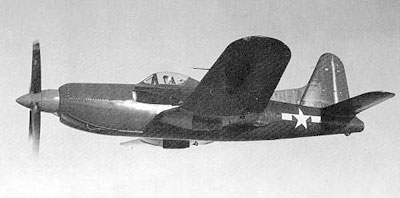 |
Ryan XF2R-1 "Dark Shark" |
Two altered Fireball designs were proposed, but not built. The XFR-2 was to use a Wright R-1820-74V of 1,500 hp. Six hundred had been ordered before YJ Day cancellations eliminated them. The XFR-3 was to add a 2,000 lb. thrust GE jet to the updated Wright.
The XFR -4 faired somewhat better. The single example used a 3,400 lb. thrust Westinghouse J34-WE'22 jet engine fed via flush air inlets on the fuselage. This Fireball was tested at the end of L944.It was found that, whereas the greater jet Power in- creased the performance at higher altitudes, the piston engine caused so much drag that neither unit could operate effectively. This, then, led to the design of the XF2R-2 which would combine the more powerful jet with the "Dark Shark" turboProp. The XF2R-2 had reached the mock-up stage before the entire program was dropped.
Ryan
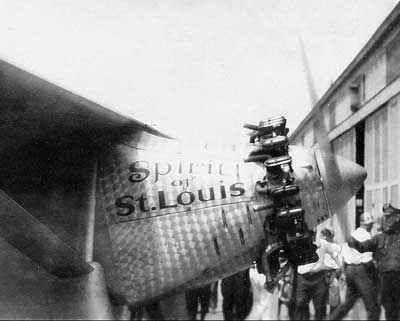 To any aviation enthusiast the name of Ryan must be for ever linked
with the Spirit of St. Louis (Ryan NYP) flown solo by Charles Lindbergh on his 1927 non-stop flight over the Atlantic ocean from New
York to Paris. The little enclosed cockpit tourer which was to become
one of the immortals of aviation had been designed by Donald Hall
and built by Claude Tubal Ryan who many years later was to develop
the first mixed propulsion unit (piston engine and jet) carrier-based
fighter.
To any aviation enthusiast the name of Ryan must be for ever linked
with the Spirit of St. Louis (Ryan NYP) flown solo by Charles Lindbergh on his 1927 non-stop flight over the Atlantic ocean from New
York to Paris. The little enclosed cockpit tourer which was to become
one of the immortals of aviation had been designed by Donald Hall
and built by Claude Tubal Ryan who many years later was to develop
the first mixed propulsion unit (piston engine and jet) carrier-based
fighter.
The FR-l, as this later plane was designated was also Ryan's only foray into the world of fighter production and it proved a fruitful and successful one. Claude T. Ryan was born in Parson, Kansas on January 3, 1898; he had wanted to enlist for service in World War I but by the time he was 18 and old enough to join the Air Service, it was 1919, and the war was at an end. He trained as a fighter pilot and had attained the rank of Lieutenant when he left the Army in 1922, well and truly bitten by the aeronautical bug.
Failing to find work in aviation, he set up a very small airline with a few war surplus Standard J-I aircraft which he had converted to accommodate four passengers each. By 1925, the company had expanded so much that it was running regular services from San Diego to Los Angeles, under the impressive nome of Ryan Airlines and had started to design and construct its own aircraft.
The Spirit of St. Louis was built after Claude T. Ryan had sold his interest in the company, while continuing to run it, and was his fifth project, a derivant of his earlier Bluebird (his first enclosed cockpit monoplane) and of the Ryan Brougham, both of which were very well known in their day. Ryan's great enthusiasm in life, however, was teaching the young how to fly: after his close involvement with the Flying Schools during the years 1928-193l, when he founded the Ryan Aeronautical Company, his one wish was to produce a basic trainer which was safe, easy to fly and reliable, in short the ideal plane for beginners.
Drawing on his considerable experience, he built the S- T in 1933, his first metal fuselage monoplane which led to the PT-20, PT-21, PT-22 and PT-25 for the U.S.Army and the equally well-known NR-1 for the U.S.Navy, 1,440 of which were produced during World War II. The FR-l Fireball was something of an anomaly, undertaken by Ryan with his usual enthusiasm, determination and single- mindedness, a new departure cut short by the coming of peace. Gradually Ryan withdrew from series aircraft production and became more and more involved with the development of guided missiles and systems for automatic landing in zero visibility and also built several research planes and experimental VTOL aircraft such as the X-13 Vertijet of 1957, and its successor, the XV-1A Vertiplane.
In 1969, the company (with a total of 5,000 employees, including engineers, administrative staff and factory workers) was token over by Teledyne Inc., with a change of name to Teledyne Ryan Aeronautical and Claude T. Ryan was asked to carry on as chief executive. Ryan certainly seems to have been cost in the mold of many American captains of industry, steering his company through both favorable and disastrous economic conditions in the rough and tumble of the fiercely competitive world of aviation; while not one of America's greatest aeronautical sagas, the company's story lives on in the memory of the unforgettable Spirit of St. Louis and, in the Fireball.
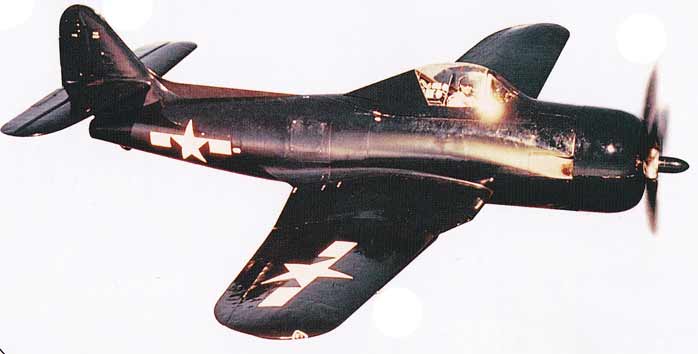 |
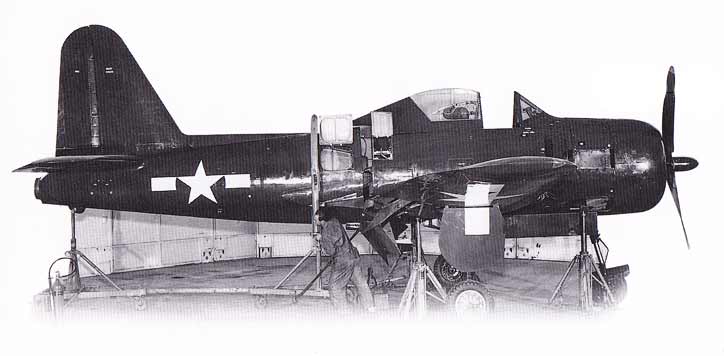 |
Specifications
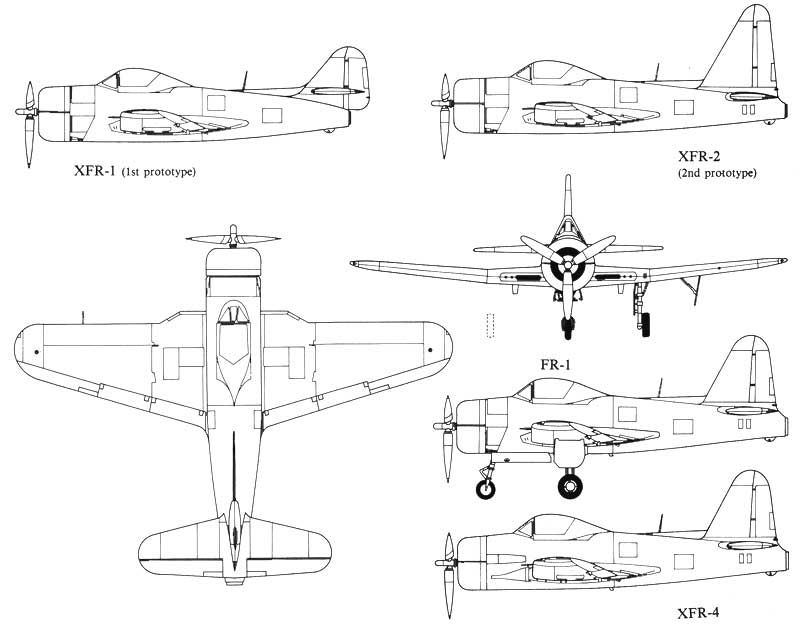 |
Crew: one Performance
|
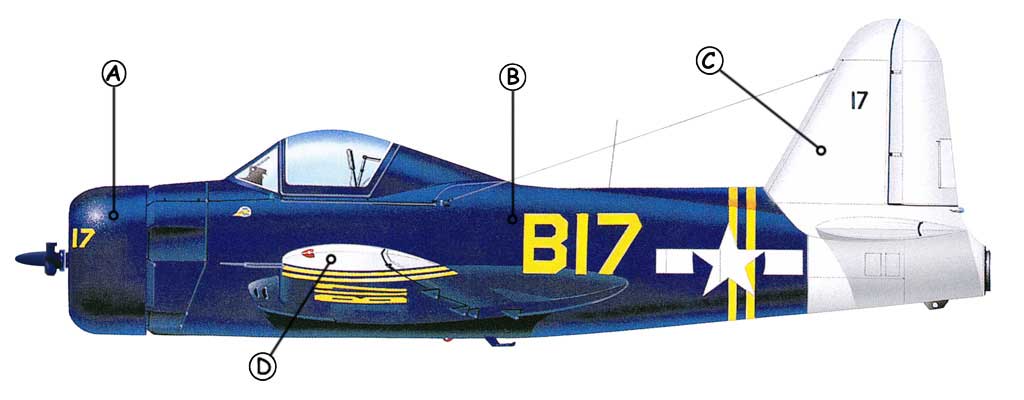 |
|||
| A: The piston engine was mainly used for take-offs and landings, and was often shut down in flight. Many photos show FR-1s cruising along with the propeller feathered. | B: By the standards of the day, the mixed-power FR-1 was very unorthodox, and resulted from the erroneous belief that pure jet aircraft were not suited to carrier operations. | C: The original tail surfaces of the |
D: The Fireball had a laminar-flow wing optimized for high-speed flight. This was the first carrier-based fighter designed from the outset to have such a wing. |
Model is under development 11/10/09.

